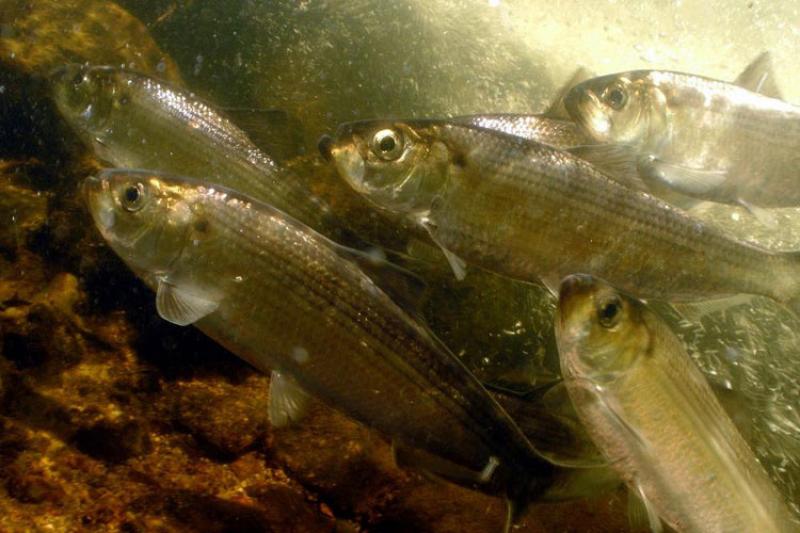Did you know that historically, river herring populations were enormous, and their populations reached into hundreds of millions? Today that is not the case. A broad review of current scientific literature on river herring in New England and the mid-Atlantic was recently published in Marine and Coastal Fisheries. It also considers Canada and the southeastern United States. It summarizes current knowledge and identifies research needs and threats, including consequences of dam construction, habitat loss, habitat degradation, and overfishing.
River Herring History
The term “river herring” is a combined name for the alewife (Alosa pseudoharengus) and blueback herring (Alosa aestivalis). River herring return to freshwater habitats to spawn, providing food to many species, nutrients to freshwater ecosystems. They play a pivotal role in regulating the food web structure. They also help support the conservation of the endangered Atlantic salmon, by being prey to predators and thus reducing the predation on salmon. Furthermore, river herring also contribute to a wide variety of important ecosystem services that benefit people.
These fish supported some of the oldest fisheries in the United States. Their historically high abundance, wide distribution, and migratory life cycle are intertwined with the human experience along the Atlantic seaboard of North America. They are culturally important to a number of Native American tribes, who celebrate the runs of river herring adults into freshwater spawning habitats along the East Coast.
Threats to River Herring
Since European colonization, almost all migratory species in eastern North America have declined in abundance. Unfortunately, river herring populations are at historical lows as a consequence of dam construction, habitat loss, habitat degradation, and overfishing. The reduction in spawning habitat by dams is the largest disturbance based on the estimated yearly loss of river herring in the area. From Maine to Virginia, there are more than 14,000 dams across the 13 states! Juvenile river herring swimming out to sea, and adults in the river and swimming upstream to spawn, are all disrupted by dams.
Dams are not the only barrier to upstream and downstream fish passage: culverts and road crossings also contribute. Other threats to river herring include:
- Poor water quality
- Contaminants that contribute to habitat degradation negatively impact river herring eggs and larvae
- Changing temperatures associated with climate change, which can adversely affect river herring physiology, growth, migration timing, and survival
How Are We Helping to Restore Populations?
Assessing river herring stocks is a daunting task. Both species use a variety of habitats from freshwater to open ocean and have broad ranges along much of the East Coast. Additionally, similarities in body shape and form between the two species add to the complexity of evaluating their stock structure. Most data collection programs and management actions to merge both species and also fish from different rivers and regions.
To help restore river herring, NOAA Fisheries and the Atlantic States Marine Fisheries Commission established a technical expert working group in 2013. It combines information about river herring and identifies needs to advance the science to help restore the species. “We were questioned when the working group was formed, but this group represents a critical step in river herring restoration by combining the knowledge and efforts of many experts and organizations,” says Diane Borggaard of the Protected Resources Division at the Greater Atlantic Regional Fisheries Office. “This collaborative framework is an approach that has helped further needs for river herring and could serve as a model for other species.”
In 2020, the working group was renamed the Atlantic Coast River Herring Collaborative Forum. The forum has been very effective in bringing together a broad group of experts to better understand river herring and to consider the complexities of river herring restoration. The collaboration between NOAA Fisheries, the Commission, and New England and Mid-Atlantic Fishery Management Councils has facilitated a number of steps to promote the restoration of the two species.
Ecosystem Approaches to Restoration
There is a need for comprehensive science and management to help restore and maintain healthy river herring populations. This includes considering all the threats to river herring holistically.
“River herring restoration is not a fisheries management issue, it is an ecosystem management issue and to be successful we need to apply ecosystem approaches,” said Jon Hare, Science and Research Director of the Northeast Fisheries Science Center and lead author of the study. Collaborative efforts across all sectors are required to manage and restore healthy river herring populations. To help restore river herring through an ecosystem approach, river herring managers, researchers, and community groups from across the species’ range need to collaborate to share and synthesize information to coordinate management and science efforts.
While there are still a number of unknowns remaining regarding how various threats and climate change will interact with conservation efforts, there is good news. One method is removing dams to increase river herring abundance by allowing them access to spawning habitats. For example, when the Edwards Dam was removed in 1999 river herring returns to the Kennebec River increased by 228 percent. When the Fort Halifax Dam was removed in 2008, river herring returns on the Sebasticook River in Maine increased by 1,425 percent.
There were also signs of improvement from the 2012 to the 2017 stock assessments. Sixteen out of the 54 rivers in 2017 exhibited increased population trends compared to 2 of 54 rivers in 2012. Much progress has been made in the past 10 years, but important data gaps still need attention. That includes the effects of contaminants and land use on river herring productivity, and a better understanding of stock structure. The next steps are to focus on creating standardized stock assessments and to promote a collaborative framework to support long-term effective restoration and conservation of river herring.




